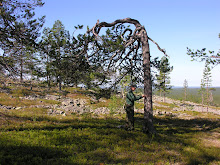This year has indeed been interesting. The thesis defence was certainly a highlight, but when it comes to personal development, teaching was the most important new challenge I faced. I started by teaching the basics of forest mensuration to our first year students in January. This information was then applied to practice as I was the assistant teacher at our forest mensuration field course. In the autumn, I continued by teaching the same bunch of students the basics of remote sensing. Congratulations to all of you who made it through! Hopefully some became interested in the forest inventory issues: for a teacher that would be the best recognition. Often the students seem to be overwhelmed by the technical stuff that is required in these courses, so few want to study it further.
Research was thus less in focus this year. Most of the time I spent dealing with lidar-based inventory of seedling stands; some working papers have already been delivered and a scientific article will follow later. In the field of canopy research my only output was to organize a new field campaign in Hyytiälä and participate in Ilkka's new field photogrammetry experiment. Now we have some quite unique new data sets; hopefully next year will bring time to squeeze everything out of them. However, before that there is some more (international) teaching to be done...
Happy holidays!
Research was thus less in focus this year. Most of the time I spent dealing with lidar-based inventory of seedling stands; some working papers have already been delivered and a scientific article will follow later. In the field of canopy research my only output was to organize a new field campaign in Hyytiälä and participate in Ilkka's new field photogrammetry experiment. Now we have some quite unique new data sets; hopefully next year will bring time to squeeze everything out of them. However, before that there is some more (international) teaching to be done...
Happy holidays!






